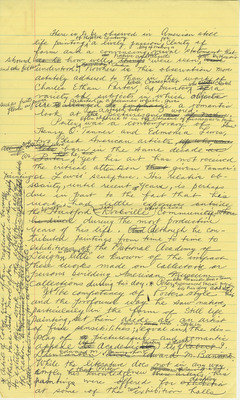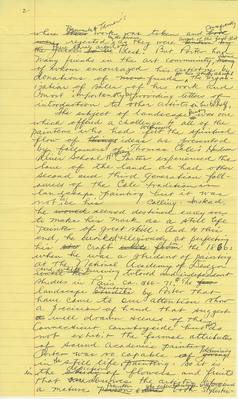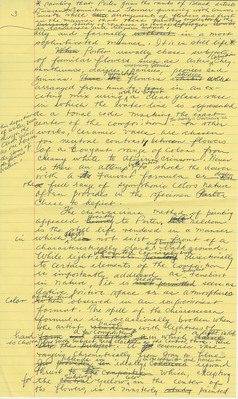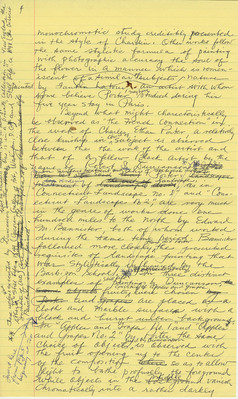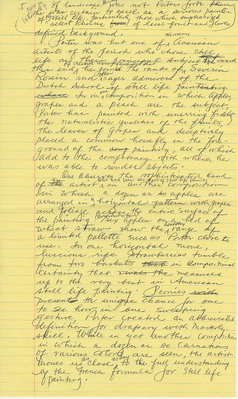Pages
MS01.01.03.B02.F16.001
[HANDWRITTEN ON YELLOW LINED PAPER]
There is to be observed in America still life painting of the 19th century a lively passion for clarity of form and a convincing way of making a visual statement that showed [crossed out] as to [/crossed out] how well [crossed out] an [/crossed out] nature and related objects were seen [crossed out] felt [/crossed out] by the artist [crossed out] used [/crossed out] and also felt and understood [crossed out] by the artist and [/crossed out]. Nowhere is this observation more astutely adhered to than in the works of Charles Ethan Porter, a Rockville, Connecticut painter who created [crossed out] of [/crossed out] a variety of subjects in which objects such as fruits, flowers and fauna are [crossed out] arranged to emphasize [/crossed out] painted in a manner which give a romantic look at [crossed out] the [/crossed out] a staged but pictures are world. [crossed out] new of nature? [/crossed out].
Porter often referred to in the literature of his day as "a painter of flowers" was a contemporary of Henry O. Tanner and Edmonia Lewis, two Black American artists [crossed out] who were all of which [/crossed out] were born in the same decade [crossed out] as [/crossed out] as [crossed out] Porter [/crossed out] he, yet his art has not received the critical attention [crossed out] that [/crossed out] given Tanner's or Lewis' sculpture. His relative obscurity, until recent years, is perhaps due in part to the fact that his work had little exposure outside the Springfield and in Rockville Hartford communities where he lived [crossed out] he lived [/crossed out] during the most productive years of his life. [crossed out] And [/crossed out] Although he contributed at the National Academy of Design in New York City, little is known of the impact these works made on collectors nor persons building American Museum collections during his day. [* INSERT] Artists of Color were often neglected because of their race. [crossed out] And [/crossed out] Most often rebuffed when they tried to exhibit their work in few of exhibition halls of the nation. [crossed out] little resistance for white artists. [/crossed out] Porter's style in his day and noted that and the profound way he saw nature, particularly in the forms of Still Life painting, set him aside as an artist of fine sensibilities exhibiting [crossed out] artistic [/crossed out] traits, equal in the style in the display of picturesque and romantic appeal in [crossed out] to [/crossed out] academic painting [crossed out] ally [/crossed out] to the work of [crossed out] Robert S. Duncanson and Edward M. Bannister [/crossed out] Edward M. Bannister. While the literature does not in any way imply that Porter [crossed out] his knowledge [/crossed out] knew Bannister or ? [crossed out] these artists [/crossed out] his paintings were offered for display [crossed out] exhibition [/crossed out] at some of the same exhibition halls
MS01.01.03.B02.F16.002
[HANDWRITTEN ON YELLOW LINED PAPER]
2
where [crossed out] their [/crossed out] Bannister & Tanner's work was taken and [crossed out] both were [/crossed out] and consequently rejected by the jurors as they were [crossed out] known by the jurors to be [/crossed out] aware of the fact that these three artists were Black. But Porter had many friends in the art community, [crossed out] many [/crossed out] some of whom encouraged his artistry by donations of [crossed out] mone [/crossed out] funds for his study abroad. The organization of sales of his work and most importantly by providing letters of introduction to other artists in his behalf.
The subject of landscape printing was one which offered a challenge to all of the painters who had witnessed felt(?) the spiritual flow of [crossed out] things [/crossed out] ideas as presented by followers of Thomas Cole's Hudson River School of Painting. Porter experienced the love of the land as had other second and third generation followers of the Cale tradition in landscape painting but it was not to be his [blank space] calling. Instead, he [crossed out] would [/crossed out] seemed destined early on to make his mark as a still life painter of great skill. And to this end, he worked religiously at perfecting his [crossed out] sh [/crossed out] craft [crossed out] while from [/crossed out] in the 1860s when he was a student of painting at The National Academy of Design [crossed out] until his [/crossed out] and while pursuing tutored and independent studies in Paris ca. 1866-71.
The [crossed out] few [/crossed out] landscape [crossed out] studies [/crossed out] by Porter that have come to our attention show a precision of hand that suggest [crossed out] a [/crossed out] well drawn scenes of the Connecticut countryside but they do not exhibit the formal attributes of sound academic painting Porter was so capable of [crossed out] giving [/crossed out] delivering in the still life. [crossed out] painting [/crossed out] So it is in the [crossed out] study [/crossed out] depiction of flowers and fruits that [crossed out] are [/crossed out] observes the artistry of a mature [crossed out] person [/crossed out] painter [crossed out] one [/crossed out] who renders his subject with confidence both stylistic --
MS01.01.03.B02.F16.003
[HANDWRITTEN ON YELLOW LINED PAPER]
3
ally and formally [crossed out] without [/crossed out] in a most sophisticated manner. It is in still life painting that Porter joins the ranks of Black artists Duncan, Bannister and Tanner pursuing with commensurate skill [crossed out] still [/crossed out] arrangements of flowers and fruit in the manner that these painters undertook the [crossed out] pursued [/crossed out] study of nature as revealed [crossed out] apologies doubt [/crossed out] in landscape and religious subjects.
[crossed out] When [/crossed out] Porter usually chose subjects of familiar flowers such as asters, carnations, chrysanthemums, daisies, morning glories, pansies, peonies and zinnias. [crossed out] These His [/crossed out] Numerous flowers [crossed out] exhibit [/crossed out] studies [crossed out] were [/crossed out] arranged from time-to-time in an exciting mix using with the bouquet a clear glass vase in which the water line is represented as a tonal code marking the exact center of the composition. The artist is convincing in his depiction of water seen through clean glass as one observes the stems of the flowers within. In other works, ceramic vases are chosen for neutral contrast between flowers of a bouyant range of colors from creamy white to alizarin crimson. Never is there an attempt by the artist to shock the viewer with a Fauvist formula or display [crossed out] even [/crossed out] the [crossed out] a [/crossed out] full range of symphonic colors nature often provides in the speciment Porter chose to depict.
The chiaroscoru method of painting appealed [crossed out] heavily [/crossed out] greatly to Porter [crossed out] and [/crossed out] seldom is the still life rendered in a manner which objects do not exist in front of a characteristically dark and brooding background. While light [crossed out] and its painting [/crossed out] while painted concisely and directionally to certain elements of the composition is importantly addressed as somewhat tenebrist in nature, it is [crossed out] not permitted [/crossed out] seldom seen as active positive space or as atmospheric color of this kind [crossed out] when [/crossed out] observed in an impressionist format. The spell of the chiaroscuro formula is occasionally broken when the artist [crossed out] renders [/crossed out] paints with lightness of hand [crossed out] form and subject, a [/crossed out] a few compositions in which [crossed out] daisies are the subject [/crossed out] a light pallette is chosen. One such subject uses daisies as the central theme. Here a ceramic vase ranging chromatically from gray to blue [crossed out] giv provides an [/crossed out] blends in ideally in the composition and provides an [crossed out] conceived [/crossed out] upward thrust [crossed out] to the composition [/crossed out] which, excepting for the [crossed out] central [/crossed out] subdued yellow color in the center of the flowers, is a masterly [crossed out] study [/crossed out] painted
MS01.01.03.B02.F16.004
[HANDWRITTEN ON YELLOW LINED PAPER]
4
monochromatic study credibly presented in the style of Chardiu (?). Other works follow the same stylistic formula of painting with photographic accuracy the soul of the flower in a manner which is reminiscent of subjects of a similar nature by Fantin Latour, an artist with whom some believe Porter may have studied during his five year stay in Paris.
Beyond what might characteristically be observed as "the French Connection" in the work of Charles Ethan Porter, a relatively close kinship in choice of subject is observed between the work of the artist and that of a fellow Black artist by the name of Robert S. Duncanson. Coincidentally, in three distinct examples of still life paintings by Duncanson, [crossed out] the same objects [/crossed out] fruits, consisting of apples and grapes, were chosen [crossed out] by Porter [/crossed out] and [crossed out] grapes [/crossed out] are placed on a clother and marble surface with a black and burnt umber background. If landscape painting was not Porter's forte then he was certain to excel as a serious painter of the still life, particularly those which emphasized select choices [crossed out] from [/crossed out] of local fruits and flowers.
These works were executed by Duncanson before he achieved a mature style in painting. [crossed out] in the 1540s [/crossed out] One is in a private collection in New England, the other two "Still Life 1849" (Corcoran Gallery of Art, Washington, D.C.) and "Still Life" ca 1848 (The Detroit Institute of Arts). [crossed out] are formal examples of American still life painting in the period [/crossed out]
In surface treatment and the choice of subjects make Porter's rendering of landscape, as in "Connecticut Landscape No. 1" and "Connecticut Landscape of 2," are very much in the genre of works done one hundred miles to the north by Edward M. Bannister, both of whom worked during the same time period. Bannister followed more closely than did Porter the prescribed requisites of landscape painting that was stylistically influenced by the Barbizon School.
In "Apples and Grapes No. 1" and "Apples and Grapes No. 2" by Porter, the same choice of objects used by Duncanson is observed with the fruit opening up to the center of the composition [crossed out] where [/crossed out] so as to allow light to bathe profusely the foreground while objects in the middle [crossed out] background [/crossed out] vanish chromatically into a rather darkly
[INSERT FOR PAGE 4?]
If landscape was not Porter's forte then he was certain to excel as a serious painter of the still life, particularly those which emphasized select choices [crossed out] from [/crossed out] of local fruits and flowers.
MS01.01.03.B02.F16.005
[HANDWRITTEN ON YELLOW LEGAL PAPER]
5
defined background.
Porter was but one of the many American artists of the period who chose still life as their principal subject [crossed out] as of [/crossed out]. Toward this end of creative accomplishment that he joined the ranks of Severin Rosein and other eager admirers of the Dutch School of still life painting. [crossed out] whose [/crossed out] In one composition in which apples, grapes and a peach are the subject[s], Porter has painted with unerring fidelity the naturalistic qualities of the fruits, the leaves of grapes and deceptively placed a common housefly in the foreground of the [crossed out] comp [/crossed out] painting, all of which add to the competency with which he was able to render objects.
One observes the sophisticated hand of [crossed out] the [/crossed out] artist who had seen the best of still life painting in another composition in which a dozen or so apples are arranged in a horizontal pattern with grapes and foliage across the entire surface of the painting. (Broad strokes) Six apples on a bed of wheat straw show the healthy range of a limited pallette such as Porter chose to use. In one horizontal move, luscious ripe strawberries tumble from two baskets [crossed out] that [/crossed out] in compositional certainty that [crossed out] rivals the [/crossed out] measures up to the very best in American still life painting. [underscored] Peonies [/underscored] present the unique chance for one to see how in one sweeping gesture, Porter created an abbreviated definition for drawing with masterly skill. While in yet another composition in which a dozen or so carnations of various colors are seen, the artist moves us as close as any to the full understanding of the French formula for still life painting.
[ COPY INSERT MEANT FOR THE BOTTOM OF PAGE 4?]
If landscape was not Porter's forte then he was certain to excel as a serious painter of the still life, particularly those which emphasized select choices [crossed out] from [/crossed out] of local fruits and flowers.
